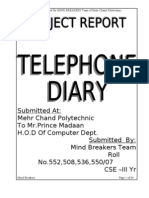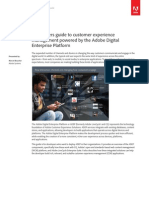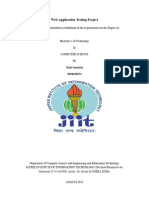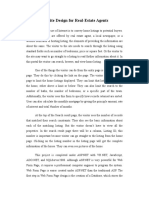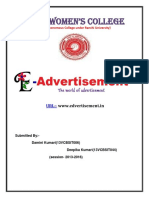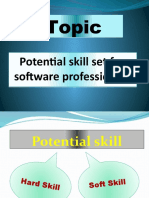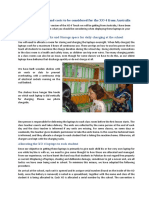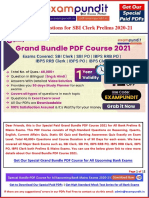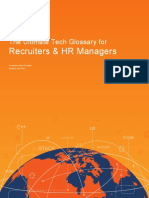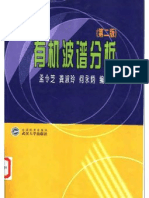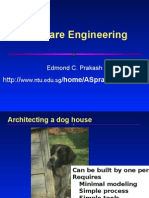0 ratings0% found this document useful (0 votes)
189 viewsConverting Applications From Advanced Revelation To Openinsight
Converting Applications From Advanced Revelation To Openinsight
Uploaded by
Shahid NadeemThis document discusses converting applications from Advanced Revelation to OpenInsight. It provides an overview of the conversion process and what does and does not carry over between the two systems. The conversion process involves 3 phases: 1) creating a new OpenInsight application, 2) accessing Advanced Revelation tables, and 3) creating menus in the new OpenInsight application. While data and some logic can be converted, user interface components like forms and screens must be recreated to comply with the Windows standard.
Copyright:
© All Rights Reserved
Available Formats
Download as PDF, TXT or read online from Scribd
Converting Applications From Advanced Revelation To Openinsight
Converting Applications From Advanced Revelation To Openinsight
Uploaded by
Shahid Nadeem0 ratings0% found this document useful (0 votes)
189 views18 pagesThis document discusses converting applications from Advanced Revelation to OpenInsight. It provides an overview of the conversion process and what does and does not carry over between the two systems. The conversion process involves 3 phases: 1) creating a new OpenInsight application, 2) accessing Advanced Revelation tables, and 3) creating menus in the new OpenInsight application. While data and some logic can be converted, user interface components like forms and screens must be recreated to comply with the Windows standard.
Original Description:
Shahid Nadeem
Original Title
Rev Conar
Copyright
© © All Rights Reserved
Available Formats
PDF, TXT or read online from Scribd
Share this document
Did you find this document useful?
Is this content inappropriate?
This document discusses converting applications from Advanced Revelation to OpenInsight. It provides an overview of the conversion process and what does and does not carry over between the two systems. The conversion process involves 3 phases: 1) creating a new OpenInsight application, 2) accessing Advanced Revelation tables, and 3) creating menus in the new OpenInsight application. While data and some logic can be converted, user interface components like forms and screens must be recreated to comply with the Windows standard.
Copyright:
© All Rights Reserved
Available Formats
Download as PDF, TXT or read online from Scribd
Download as pdf or txt
0 ratings0% found this document useful (0 votes)
189 views18 pagesConverting Applications From Advanced Revelation To Openinsight
Converting Applications From Advanced Revelation To Openinsight
Uploaded by
Shahid NadeemThis document discusses converting applications from Advanced Revelation to OpenInsight. It provides an overview of the conversion process and what does and does not carry over between the two systems. The conversion process involves 3 phases: 1) creating a new OpenInsight application, 2) accessing Advanced Revelation tables, and 3) creating menus in the new OpenInsight application. While data and some logic can be converted, user interface components like forms and screens must be recreated to comply with the Windows standard.
Copyright:
© All Rights Reserved
Available Formats
Download as PDF, TXT or read online from Scribd
Download as pdf or txt
You are on page 1of 18
201 Broadway Cambridge, MA 02139 Phone: (617) 577-0300 Fax: (617) 494-0008
A Division of Revelation Technologies, Inc.
Converting Applications from
Advanced Revelation to OpenInsight:
n n n n n n
Perspectives from Developers
Converting Applications FromAdvanced Revelation to OpenInsight
Revelation Software page 1 of 17
n n n n n n
INTRODUCTION
Since our inception in 1987, Revelation Software has been dedicated to delivering a fully integrated application
development environment that is optimized for local area network and workgroup computing environments.
Advanced Revelation is an award-winning environment that provides a complete set of non-procedural application
development tools, a robust programming environment, and a flexible, variable length, multi-valued database that
enable security and performance on large multi-user networks.
In response to the explosion of demand for graphical user interfaces using Microsoft Windows, in 1993 Revelation
delivered OpenInsight, a complete Windows compliant development environment. The objectives with the delivery
of OpenInsight were:
1. Provide an uncompromised development environment that completely supports Windows user interface
standards, event-orientation and object properties.
2. Deliver an environment that was language and database compatible with Advanced Revelation. This capability
was required to enable our customers to leverage much of their prior investment in Advanced Revelation
applications and bring them forward into Windows.
3. Provide a breadth of tools comparable to Advanced Revelation. OpenInsight provides Windows versions of a
forms painter, popup builder, R/List, messages, help, and QuickEvents (equivalent to the "Code and
Command" concept)
4. Set the stage for fulfillment of our mission of delivering a new generation of application development tools
that enables iterative application development through repository technology; providing version control, check
in/out, object browsing, and automated application distribution.
Revelation also recognized that technologies have advanced and matured rapidly to where PC's are becoming less
computing devices and more communication devices. The next generation of Information Systems will leverage
these technologies to deliver well integrated workgroup and workflow capabilities. Last year, OpenInsight for
Workgroups was delivered to application developers who require the following;
1. Ability to exploit client/server architectures, enabling developers to connect natively to a wide variety of
database structures that will be dispersed; SQL Server, ODBC, flat file, and unstructured database formats
such as Advanced Revelation files and Lotus Notes.
2. Object oriented methodologies providing the means for reuse and sharing of application components and
architecture.
3. Workgroup, workflow, and messaging technologies that enabling business applications to be extended
internally and to customers, suppliers, and business partners outside the enterprise.
4. A platform for supporting the Internet and world wide web. As applications become more externally oriented,
a new class of non-mandatory or elective users will need to be serviced. Organizations will need to provide
richly visual, intuitive systems to those outside the organization to attract them to doing business with their
organizations.
5. Repository technologies which provide the means for integrating and managing application components.
Many end users are now requiring that new versions of their applications be graphical and communications based -
technologies such as Windows, Lotus Notes, and Internet are being demanded. Many companies have been
reducing the many barriers to Windows incrementally; investing in hardware, software, training, and application
migration. The purpose of this document is to outline the steps that an Advanced Revelation developer would
follow to convert an Advanced Revelation application to OpenInsight for Workgroups cost effectively.
These techniques are outlined in three separate articles written by professional application developers, each of
whom have successfully converted a number of Advanced Revelation applications to OpenInsight. The articles
begin with "Converting Advanced Revelation Applications to OpenInsight" which describes in detail the
appropriate steps to follow in migrating your application to Windows. "Sharing an application between Advanced
Converting Applications FromAdvanced Revelation to OpenInsight
Revelation Software page 2 of 17
Revelation and OpenInsight" discusses how you can migrate your application to Windows while still using your
Advanced Revelation application. The last article "Preserving you skills: Tools and Techniques in Advanced
Revelation and OpenInsight" provides a number of useful comparison charts showing the methods with which to
implement similar abilities across the two products.
n n n n n n
CONVERTING AREV APPLICATIONS TO OPENINSIGHT
The "good news"
There are many aspects of your Advanced Revelation application that will translate into OpenInsight. Here's what
you can convert: data files, dictionaries, indexes, and the basic logic of your programs - and the best news: you
don't have to re-enter your data. You will need to evaluate the user interface components of your application and
determine how to make these forms, messages and popups Windows compliant.
What doesn't get converted?
The components that communicate to the user must now use the Microsoft Windows user interface standard and
must be recreated or evaluated. Remember that Windows is an entirely new environment. It would be a big job (if
it's even possible) to convert DOS-based data entry screens and programs to an object-oriented programming style.
It is not surprising that data entry screens are not converted, because the behavior of screens under Advanced
Revelation and OpenInsight is completely different. It is not that OpenInsight is different, it's Windows itself. In
Advanced Revelation there is a controlled program flow throughout an entry screen. The programmer knows
what's happening, and where it's happening. In Windows it's not that simple. OpenInsight, like any other Windows
application, allows the user to enter and exit fields on a screen at will. A logical progression of prompts is removed
and, therefore, so is straightforward program flow.
Some of the ideas are the same, however. For example pre-prompt and post-prompt hooks are almost the same as
the gotfocus and lostfocus events that you can capture in any object in the window.
On to the conversion process...
Before we discuss how to convert the user interface components of your application, lets first examine what you
need to consider before converting:
1. Decide whether your OpenInsight application will share tables with Advanced Revelation. If your application
will not share data, copy your data tables into a different sub-directory for access by OpenInsight only. If you
don't do this, you may end up sharing tables whether you want to or not. If you want to share the data, please
see the following article entitled "Sharing an application between Advanced Revelation and OpenInsight"
2. OpenInsight does not support periods in table names. You can convert file names while still in Advanced
Revelation by running Update Application (in the SYSOBJ table), choose Tables, and then choose "Convert
Dots to Underscores".
Phase 1. Create a newapplication
Login to OpenInsight with the user name of SYSPROG and choose New Application from File menu. Fill in the
Application ID name (no spaces), Title (a description), Author Name, Password, and Company if you like. Since
we are not basing this application on an existing OpenInsight application, leave <Default Inheritance> alone. Click
OK and the application will be created.
Phase 2. Access AREV Tables
If your application is not open, choose Open Application from the File menu. Choose Database Manager from the
Tools menu, then click File, Add. Make sure "Drives" and "Directories" are pointing to the correct location of your
Converting Applications FromAdvanced Revelation to OpenInsight
Revelation Software page 3 of 17
AREV tables, then choose the data tables you want added from the Tables box by clicking the Table name and
clicking Add. If you want everything click the Add All button.
The tables you selected should now be listed in the Add Tables box. Click OK and then choose Save from the
Database menu. You have now "ATTACH"ed your data by setting an image within OpenInsight pointing to your
Advanced Revelation tables in the location you specified.
Phase 3. Create menus
Now create an MDI Frame in the Form Designer that will act as a menu. On this form you can place buttons,
bitmaps, icons, and a menu that your users can click on to navigate through your application. This is just one
method of getting your forms, windows, reports, etc. to run.
To build an MDI Frame, from the Application Manager, choose Form Designer from the Tools menu and then
choose New MDI Frame from the File menu. Since this is your first Form, you don't have a style sheet defined, so
click on OK to continue. You should see a default menu and an "MDI Client Window" which serves as the
workspace in which your data entry forms, popups, and messages will appear. In most Windows applications you
should allow the majority of the MDI Frame to be filled with the "MDI Client Windows" except for an area at the
top of the frame that will provide a space for a toolbar. Toolbars can be created by dropping a series of equally
sized
buttons onto the frame.
To customize the default menu, choose Menu, then Design. At the " Menu Popup/Item" prompt, type in the name
of the first selection for your menu. This is the name that appears on your menu as a choice for the user. Press
[Enter] and you'll be moved to the next level under your choice to define the submenu. To move back to the top
level, press the left arrow key and type the next main selection of your menu.
If there is a blank entry at the end when you're finished, delete it and choose Exit/Update from the File menu. Now
double-click the window background and fill in the system name for your menu and a Title to display to your users.
Choose Save from the File menu, then exit back to this menu once we have forms or windows to attach to the menu
selections.
Phase 4. Set up the entry point into your application
The entry point is the name of the form you wish to display when a user first logs into your application. To specify
the appropriate form, go back in the Application Manager choose Application Properties from the File menu and
click Setup Entry Point. A list of windows will be displayed and choose the name of the Menu window you created.
Click OK twice, and your entry point is set.
Phase 5. Create forms
If you're building a form from a table you've already added (as we did earlier), skip to the next paragraph.
Otherwise, in the Application Manager choose Database Manager from the Tools menu, then choose Add from the
File menu. Add the table you want to build your forms with to the Tables list box and click OK.
In the Form Designer choose QuickForm from the File menu. Double click the table you want and choose the fields
you want. You can choose Add All, but if there are too many fields to fit in your displayed window space, it's tough
to get to them after the form is built. So just add a few of your fields for now, then go back and add the rest later.
You'll have to put on your artistic hat and make your form look polished by rearranging and resizing your controls.
Save your form.
Phase 6. Let's put it all together
You're still in the Forms Designer, so choose Open from the File menu and open up the menu window you created.
Choose Menu, then Design from the Forms default menu and click your first menu selection. Choose QuickEvents
Converting Applications FromAdvanced Revelation to OpenInsight
Revelation Software page 4 of 17
from the Events menu and in the Summary of Event Handlers dialog box, select your menu item again and click
the QuickEvent button. Choose Execute a Window from the QuickEvent Options and in the Send Message To
section click the drop-down arrow of the entry field, then select the form you would like to display. Click OK, then
close the Summary of Event Handlers dialog box and repeat the process for all your menu items.
Remember, as with all window controls, you can put "&" in front of any character in your menu item to add Alt-
key access (Marked with an underscore) to the selection. You can also assign accelerator keys to your menu items
in the Menu Designer.
Phase 7. Change your R/BASIC programs
Most of your code remains in OpenInsight, but Windows is a different world, so there are some changes.
Specifically, implicit formatting is not supported, so you would have to write:
x = FMT('name', 'L#40')
instead of
x = 'NAME' 'L#40'
Generally some user interface code must be rewritten because routines like MSG are different and others like
INPUT.CHAR and CATALYST (replaced by QuickEvent) are not applicable in windows. Commands like
PERFORM, EXECUTE, and PCPERFORM are now handled by the UTILITY function and the WRITE statement
must now contain a full THEN/ELSE clause. Table 1 is a list of unavailable R/BASIC commands and the
corresponding Basic+ commands.
General Comparisons
Data tables
No change between Advanced Revelation and OpenInsight.
Dictionary tables
AREV 3.1 and above, no change. Prior versions below AREV 3.1, the dictionary will not carry flags that indicate
exclusive use by OpenInsight or Advanced Revelation. If you plan to share data, upgrade to AREV 3.1.
Indexes
Advanced Revelation 3.0 and above, no change. Below 3.0, remove all indexes and reinstall them under
OpenInsight.
MFSs
Advanced Revelation 2.0 and above, no change. Below 2.0, refer to Technical Bulletin #43, "Modifying MFSs and
BFSs for the 2.0 BFS specification."
Environment records
Definitions for the environment are now attached to the database, not the user. Most of the other utility work such
as printer definitions are configured via Microsoft Windows.
Menus
As you've seen, menus are attached to forms under OpenInsight.
Data entry windows
New terminology: data entry windows with tables attached are called forms. What we know as "collector" windows
are also called forms. The only difference is whether a table is assigned to a form.
Converting Applications FromAdvanced Revelation to OpenInsight
Revelation Software page 5 of 17
Popups
Most of the Advanced Revelation pop up features have been reproduced and extended in OpenInsight 2.6 and
OpenInsight for Workgroups.
Help
Application Helpnotes is a system-wide facility quite similar to the AREV help system.
Reports
Report Designer is the main reporting tool in OpenInsight and provides drag & drop, banded, two-pass reporting.
Since this is a new tool, all reports using Report Designer will need to be built from scratch. Revelation has also
provided "Report Builder" which replaces EasyWriter to create R/LIST reports. OpenList replaces R/LIST. QBF
replaces QBE.
Filters
You need to implement filters through your own Basic+ stored procedures
Messages
The parameters you pass MSG are quite different, and MSG now calls the Windows MsgBox API. The capabilities
of MSG are still the same, and there is a Message Builder to assist you in creating messages boxes.
Assembly language or C routines
These must be DLLs called from your Basic+ programs. The OpenInsight Technical Reference Manual has more
information on DLLs.
Security
Security is implemented on a component basis, which means you can control who has access to each and every
window, form, report, table, and so on.
Source and object code location
No matter where you are editing your source, upon compilation the source code is written to the SYSPROCS table
and the object code is written to SYSOBJ. Therefore there is no need to catalog anything; OpenInsight already
knows where it is.
General equivalents between AREV and OI
Table 1 documents R/Basic commands that are not applicable in OpenInsight as well as new commands
introduced. Table 2 is a comparison chart between Advanced Revelation Terminology and OpenInsight.
Converting Applications FromAdvanced Revelation to OpenInsight
Revelation Software page 6 of 17
Table 1
Removed R/Basic Commands New Basic+ code New Basic+ code
@ GET_STATUS GET_STATUS
ABORT GETPOINTER GETPOINTER
BREAK KEY GETVALUE GETVALUE
CHAIN LOCKVARIABLE LOCKVARIABLE
CLEAR SET_FSERROR SET_FSERROR
CLEAR COMMON SET_STATUS SET_STATUS
CLEARDATA UNLOCKVARIABLE UNLOCKVARIABLE
DATA
ECHO
EXECUTE
EXPENDABLE
FIELDCOUNT*
GETBREAK (GETECHO, GETPRINTER, GETPROMPT)
GET.CURSOR
INMAT()
INP
INPUT
OCONV(MOX)
OUT
PCPERFORM
PERFORM
PRINT**
PROMPT
PUT.CURSOR
STOP
SUSPEND
*No longer an opcode; replaced by the function FIELD_COUNT, which must be declared and compiles
**Unless used in conjunction with PRINTER ON
Table 2
Advanced Revelation OpenInsight
Data tables Data tables
Dictionary tables Dictionary tables
AMV (associated multivalued) group Edit table
Boolean field Check box, Radio button
Standard prompt Editline
Collector window Window (non-database-aware)
Label Static text
Multivalued field List box
Indexes Indexes
MFSs MFSs (Basic+ stored procedures)
Assembly or C routines Rewrite to DLL's outside of OpenInsight
Applications, locations, users Applications, databases, locations, users
Environment records Database environment, Windows
Menus Menus (defined in the context of a form)
Data entry windows Forms/windows (collectors)
Messages OpenInsight MSG
Popups OpenInsight popups
Reports OpenList, Basic+ stored procedures
Filters Basic+ stored procedures
R/Basic programs Basic+ stored procedures
Help OpenInsight Application HelpNotes
User Levels (Security) Entity-level security, Basic+ programs
Converting Applications FromAdvanced Revelation to OpenInsight
Revelation Software page 7 of 17
n n n n n n
SHARING AN APPLICATION BETWEEN ADVANCED REVELATION AND OPENINSIGHT
by Michael Ruane
Michael Ruane is a principal or WinWin Solutions, a consulting firm specializing in Advanced Revelation and OpenInsight. Mr.
Ruane can be reached by telephone at (201) 722-9814 and via email at info@winwinsol.com.
What makes OpenInsight so special is the fact that it can use the same data, dictionaries, and indexes as Advanced
Revelation, even at the same time! In fact, most of the R/Basic code written in the Advanced Revelation can be
used in OpenInsight with little or no modification. In this article I'll show you what you need to do and watch out
for to have your Advanced Revelation and OpenInsight systems share the same data.
Before I discuss the particulars of sharing an application between Advanced Revelation and OpenInsight, I should
discuss a few reasons you would share an application instead of converting it completely.
Change Incrementally
Making the switch from a character-based application to a Windows-based application is a monumental paradigm
shift. Users who aren't mouse-proficient or who are just adverse to change will probably have a difficult time with
the new system. But if you share an application between Advanced Revelation and OpenInsight, the change can
come gradually - one or two data entry screens at first, then maybe a report. This slow migration allows users to
become acclimated gradually, making it easier for them to accept the new system.
Use existing knowledge
From a developer's point of view, programming concepts in OpenInsight are similar to those in Advanced
Revelation. Many Advanced Revelation features - pre-prompt and post-prompt processing, pre-save and post-save
processing, options, and the message subroutine (MSG) - are all available in OpenInsight, but are slightly different
because of the Windows paradigm shift. Sharing parts of your application between the two products will allow you
to learn the lay of the land of the Windows world without adversely affecting your existing Advanced Revelation
application.
Prerequisites
Before you share an application between Advanced Revelation and OpenInsight, note the prerequisites listed
below.
Microsoft Windows 3.1 or Windows for Workgroups 3.11.
Either OpenInsight Version 2.5 or OpenInsight for Workgroups Version 3.0. Both are available right now.
You can share applications with either version of the product, I recommend Workgroups because of ODBC,
SQL Server and Notes capabilities.
Advanced Revelation version 3.1 or above. This is very important, because only with this version do dictionary
items contain a value in field 34, which is equated to DICT_PRODUCT. The values are:
0 or null Both Advanced Revelation and OpenInsight
1 Advanced Revelation only
2 OpenInsight only
Without this information (and some other changes made to the dictionary structure for 3.1), the data, dictionaries,
and indexing cannot be shared. Even though earlier versions of the dictionary might look similar, DICT.MFS will
know how to handle the data in field 34. It is important to remember that the requirement for Advanced Revelation
3.1 is only if you want to share data - if you are looking to do a wholesale migration to OpenInsight and don't care
about using the data in Advanced Revelation anymore this requirement is waived.
Both applications must be running on a network. The AREV.EXE and OINSIGHT.EXE programs do not talk
to each other directly, and so neither acknowledges the other's local lock table. Therefore, both products must
use network locking. If you are not on a network or do not have the correct network drivers loaded, you will
not be able to lock correctly between the two products.
Converting Applications FromAdvanced Revelation to OpenInsight
Revelation Software page 8 of 17
Use existing hardware
Our clients have PC equipment ranging from the original IBM PC up to the latest Pentium machines. Because
Windows doesn't run very well on the 4.77 MHz 8088 chip, clients with those machines won't be able to run either
Windows or OpenInsight. It has been our experience that the minimum machine configuration to run OpenInsight
and Advanced Revelation together is a 386-33 with 8MB of RAM. Rather than force users to upgrade all their
equipment, we can allow them to use the computers they have, and log into Advanced Revelation or OpenInsight
as it suits their hardware.
Exploit Windows without a full conversion
If your application needs to pass data to Windows-based applications such as Microsoft Excel or Microsoft Graph,
the task is much easier with OpenInsight. Getting data between Advanced Revelation and Windows-based
applications is laborious at best, but with OpenInsight it is almost painless. Dynamic data exchange (DDE) and
Multiple Document Interface (MDI) are available now, and Object Linking and Embedding (OLE) is coming later
this year, opening new avenues of data interoperability. If you share your application between Advanced Revelation
and OpenInsight, most users can use the Advanced Revelation system they are used to, while a few users use an
OpenInsight application to pass data between the two platforms.
Exploit OpenInsight without a full conversion
A number of tools available in OpenInsight can enhance your existing applications. The new Report Designer in
OpenInsight is an incredibly powerful tool, allowing you full OLE capabilities to insert graphics and pictures in
your report, use multiple fonts and font sizes, and read Advanced Revelation 3.1 data. Imagine an employee report
listing employee information and showing the employee's picture! This is available right now when you share an
application between Advanced Revelation and OpenInsight.
Mouse-optional applications
You might want to have two separate front ends to your system, based on whether users prefer using the mouse.
Managers, executives, and directors might want point and click their way through the system, starting at the top
and drilling down to the data they need. However, data-entry personnel might still want a character-based
application for familiarity and speed. Sharing an application between Advanced Revelation and OpenInsight will
satisfy both
groups of users.
Experiment
Finally, If you want to see how your application would look in Windows, sharing an application with OpenInsight
gives you a preview. You can try different types of menus - drop down menus, icons, buttons, and so on - without
affecting your existing application. You can re-evaluate your screens and reports, making any changes needed, and
take advantage of whatever GUI tools you want.
Howto share an application
The steps listed below outline the general procedure for sharing an application between Advanced Revelation and
OpenInsight. You'll find that the procedure is easy and relatively painless. In the sections following I'll discuss
individual steps in greater detail.
1. Confirm that the dictionaries in Advanced Revelation 3.1 are clean. By clean, I mean the following:
No dots allowed (underscores only) in table and column names.
Data typing is correct. OpenInsight requires that all dictionary columns have data typing. If you
migrated your application from Rev G to Advanced Revelation 3.1, you might still have an
R/DESIGN dictionary description in the data field (12).
Field contents are up-to-date. Some fields in the dictionary have been used differently in previous
versions of Advanced Revelation or Rev G. For example, the single or multi-valued field, SM, at one
Converting Applications FromAdvanced Revelation to OpenInsight
Revelation Software page 9 of 17
point contained M1.1 or M1.2, instead of only S or M. Give the dictionary records the once over and
make sure all is in order.
2. Make a new application in OpenInsight that uses the same application name as your Advanced Revelation
application (account). This is not absolutely necessary, but makes things easier to remember.
3. Add Advanced Revelation tables to the OpenInsight database definition. This is a simple as telling
OpenInsight where the Advanced Revelation tables resides; the system does the rest.
4. Create your windows in OpenInsight. You will not be able to port your windows from Advanced Revelation to
OpenInsight. However, recreating them is not difficult at all thanks to the tools provided in OpenInsight.
5. Convert your reports to OpenInsight , or create new ones. R/BASIC reports can probably be converted with
only minor changes. R/LIST and Easywriter reports need to be recreated or converted because of changes
between R/LIST and Report Builder. Don't be confused between Report Builder (a Windows based version of
R/LIST) and Report Designer (a new drag & drop, banded reporter writer) which is also provided in
OpenInsight.
6. Create new menus in OpenInsight. You have many new options for the look and feel of menus in OpenInsight,
including icons, buttons, and drop-down menus.
This list does not cover all the pieces in an application, but does allow you to get to your data, enter and modify it,
and access it through reports.
Adding Advanced Revelation tables to OpenInsight
First, create a new application in OpenInsight with the same name as your Advanced Revelation application. Once
the application has been opened, follow these steps to access to your Advanced Revelation tables:
1. From the Tools Menu, click Database Manager to display the Database Manager menu.
2. From the Database Manager menu, choose File, then Add. OpenInsight displays the Add Tables window.
3. If it is not already set, set the table type to "OpenInsight tables". Include Advanced Revelation tables.
4. Using the Directory and Drive windows, set the correct path to your application data tables. Once you have set
this path, the Tables window will fill up.
5. Individually tag the tables you want to add, or choose Add All to add all of them.
That's all there is to it! Repeat these steps as many times as necessary to add all your data tables. Don't worry yet
about the tables containing programs and window.
When you're done with these steps, you can access your data, dictionaries, and indexes in OpenInsight. If you're
running on a network, all locking will be coordinated between the two applications correctly.
There are some additional points to keep in mind after you've converted:
If you create a new table in Advanced Revelation that you want to access in OpenInsight, you must add it
manually to the table definitions as described earlier. Otherwise OpenInsight doesn't know that the table
exists.
If you add an indexes to a table in the Advanced Revelation, you must manually add the new index table (one
file) to OpenInsight as described earlier.
Creating Windows in OpenInsight
The following describes one way to create windows quickly in OpenInsight. (Actually, they're referred to as forms
in OpenInsight).
1. Click Form Designer in OpenInsight's main window. Or choose Form Designer from the Tools menu.
2. Choose QuickForm from the File menu. (QuickForm is a lot like Quick Paint in Advanced Revelation).
3. In the Table box, double-click the name of the table containing the data you want to import. If you don't have
too many columns (let's say eight or less), click Add All to add all of the database columns. Otherwise, choose
only about eight columns. You can add the rest manually later. I recommend that you limit the number to
Converting Applications FromAdvanced Revelation to OpenInsight
Revelation Software page 10 of 17
eight because when you choose more, the prompts and labels display oddly, and it's usually more work to
straighten that problem out than it is to add columns manually.
4. Click OK to save the columns you've selected. OpenInsight creates the form automatically, using the column
names as text labels.
5. If you want, you can resize and smooth out the window controls. For example, you might want to revise the
text labels or move edit line controls.
6. Repeat the process for each of the windows you need to duplicate from your Advanced Revelation application.
Those are the basic steps. There are a few additional considerations if your window uses symbolic columns or
contains multiple pages, or if you want to add columns to the dictionary. In addition, because OpenInsight's
window processing is very different from that in Advanced Revelation, you must redesign the processing currently
handled by commuter modules in Advanced Revelation.
Symbolics
Because of the way OpenInsight performs window processing, @record is loaded when the record is read off disk,
and isn't maintained dynamically by the system during the window process. Therefore, symbolics that use @record
references will get out of date quickly. There are two workarounds:
Use the {} operators. These invoke the CALCULATE system stored procedure (SSP) which will update the
data correctly.
Call the CALCULATE SSP directly. This technique is documented on page 61 of the OpenInsight Technical
Reference Manual.
Multi-page windows
Multi-page windows are now available in OpenInsight. You may use the built in ability provided in the Form
Designer, use a tab control outlined in the OpenInsight for Workgroups sample application, or you can devise a
convention to call another window for adding more data to the same record. One possible way is to create a button
labeled 'Page 2' or 'More', then write event handling code to call the next window. When users click the button, the
handler would have to save the record in the current form, unlock the key, and call a new window and pass it the
key.
Adding columns to the dictionary
If you use OpenInsight's Window Designer to add a column to a dictionary while Advanced Revelation users are
sharing the application, the Advanced Revelation users must re-attach that table. If you add columns by choosing
Edit Column Attributes from the Database menu in the Form Designer, the OpenInsight Table Builder recreates
the table and assigns it a new DOS file name.
Recreating commuter modules in OpenInsight
Commuter modules in Advanced Revelation will not convert directly to event handlers in OpenInsight, and this is
probably for the best. The major reasons they won't work are that window_common% is no longer available and
that @record is no longer maintained dynamically by the system. Any references to those variables have to be
changed.
In addition, the idea of using one large program to support a window is still feasible with OpenInsight. Because
OpenInsight is event-driven, actions like pre-prompt and post-prompt processing must now be treated as gotFocus
and lostFocus events. Each event can have event handlers associated with it, written in Basic+. An event can also
have a QuickEvent associated with it, which is a 'fill in the blank' event handler that can execute one of a number
of events such as calling help, displaying a popup, closing a window, or more.
On the surface, it might seem that window processing has gotten more difficult in the event-driven environment.
However, it has been my experience that most behind-the-scenes processing has actually gotten easier. You can set
values or actions in a form using one command: SET_PROPERTY. This is true for all controls in a form, whether
Converting Applications FromAdvanced Revelation to OpenInsight
Revelation Software page 11 of 17
they are text labels, edit lines, edit boxes, edit tables, or whatever else you might have. You no longer have to try to
find just the right combination of display.action, reset, and amv.action to make a window behave properly.
Some processing that you are used to doing with commuter modules is now handled automatically by OpenInsight.
At the same time, other processing that used to be automatic in Advanced Revelation isn't any longer in
OpenInsight. In order to make your windows look good and behave properly, you must really think about how they
will be used in the GUI environment. Use buttons instead of softkeys. Use checkboxes or radio buttons for boolean
columns. There are a lot of new possibilities - explore them!
Converting R/BASIC reports
A number of R/BASIC commands won't work in OpenInsight's Basic+, as described in the earlier article. The
following is a list of differences between R/BASIC and Basic+, which also suggests workarounds for your
R/BASIC reports.
Reports must be called from a parent window using an event. An advantage is that this allows you to use dialog
boxes, calls to the MSG() subroutines, and other user interface elements.
The STOP command is no longer valid; all programs must end with RETURN 0.
All WRITE commands require a conditional branch (THEN/ELSE clause). This is optional in Advanced
Revelation.
No dots are allowed in table names or column names.
The PERFORM and EXECUTE commands are no longer supported. Use the RLIST() subroutine instead. For
example:
CALL RLIST('SELECT EMP BY EMP_NO',5,",")
The final three parameters will always be the same. Many Advanced Revelation TCL commands are available in
OpenInsight as subroutines, such as MAKE_TABLE_SUB() and DELETE_TABLE_SUB() - use them when
possible. Remember that the RLIST() subroutine is not a direct replacement for Advanced Revelation's PERFORM
and EXECUTE - it supports only the OpenList SELECT and LIST statements. You cannot use the RLIST()
subroutine to execute windows, popups, or any other Advanced Revelation TCL commands.
The PRINT command works only if a PRINTER ON command has been executed beforehand. Even then,
because of the way Windows works, the report will not print unless you execute a PRINTER OFF command
after the report is done.
You can no longer call collector windows. Instead, use dialog boxes, which you can display using the
DIALOG_BOX() command.
The MSG() does not work the same way in Advanced Revelation and OpenInsight. For example, there is no
"UB" message type. Refer to the OpenInsight documentation for the changes in syntax.
Instead of displaying a status line gas gauge to indicate activity, change the shape of the icon to an hourglass
using the UTILITY() subroutine...
Implied format statements are not supported. For example, this statement does not work in Basic+:
Print "John" "L#40"
Instead, use the FMT() or OCONV() functions to format data:
Print FMT("John","L#40")
To preview the results of a SELECT command, use the OR_VIEW() subroutine to list the rows you selected.
Some additional points to consider when moving R/BASIC programs from Advanced Revelation into OpenInsight
are these:
Converting Applications FromAdvanced Revelation to OpenInsight
Revelation Software page 12 of 17
If your programs are in the SOURCE table, and it has PROGRAM.MFS installed on it, you must either move
the MFS into OpenInsight first, or you must remove the MFS before you add the source table to your
OpenInsight application.
If you are going to use the same programs in both OpenInsight and Advanced Revelation, you might need to
determine if you are in Advanced Revelation or OpenInsight from within a program. One way is to check
SYSTABLES for the existence of the SYSREPOS table; it it's there, you're in OpenInsight.
Object code for your programs must reside in the SYSOBJ table in OpenInsight. OpenInsight automatically
stores object code in this table when you compile your programs in the System Editor.
Windowprocessing equivalents
This table shows the equivalents between Advanced Revelation's and OpenInsight's processing hooks. For the most
part, it isn't too far a stretch to see the relationship between the two groups.
Advanced Revelation OpenInsight
Window Event
Pre-prompt GotFocus
Post-prompt LostFocus
Options Options
Pre-, Post-delete Delete
Pre-, Post-read Read
Pre-, Post-write Save
Post-application Close
Pre-application, Pre-init Create
Help Notes, Help
Pre-, Post-refresh Clear
Remember that when you write event-handling code for pre-processing or post-processing (for example, pre-read
or post-read), you must forward the event using the FORWARD_EVENT or SEND_EVENT commands.
R/LIST reports
OpenInsight provides Report Designer, which is a visual, drag & drop, banded report writer. If you use Report
Designer (and I recommend you do) you will need to recreate all of your reports. Revelation has provided a tool
"Report Builder" that will allow you to use the familiar R/LIST language and reports. If you know R/LIST, you'll
find Report Builder very similar, lacking only the COUNT and SORT commands, and differing in other small
details.
You can run Report Builder reports the System Monitor, using the RLIST command. The syntax is:
RUN RLIST "listStatement", {OPTION}
Set the options to zero or null for output to the printer, or 1 for output to the screen. The default destination for the
report is the printer, so be sure to specify 1 if you want a screen report, or you'll end up wasting a lot of paper.
There are five other options, documented in the OpenInsight KnowledgeBase document.
Other differences include:
Report Builder does not support in-line formulas.
Report Builder does not support the use of parentheses to change the precedence of AND and OR.
Reports sent to the screen do not show headings, footings, or column headings, although these do appear when
you send a report to the printer.
When you run Report Builder, there is no way to terminate the report prematurely.
Converting Applications FromAdvanced Revelation to OpenInsight
Revelation Software page 13 of 17
The SELECT statement is trickier and more involved to use, and appears to work well only when called from
programs. Put your filtering criteria into your RLIST statements and you'll be better off.
To view reports on the screen, OR_VIEW is probably the tool of choice. It is a report viewer that allows you to
view the pages of the report, and send the output to the printer. Its syntax is:
OR_VIEW "reportName" "RlistCommand"
You can use either a report name or a Report Builder command, not both. The reportName parameter is the name
of a report that was build using the Report Builder.
Alternatively, use the OR_PRTF command to send your report to a DOS file, which makes it the equivalent to the
Advanced Revelation PDISK command. Its syntax is:
OR_PRTF "reportName" | "RlistCommand", "dosFileName"
As with the OR_VIEW command, you can use either a report name or an RLIST command, but not both.
Conclusion
Sharing an application between Advanced Revelation and OpenInsight is actually quite easy. The people at
Revelation have made this task as painless as possible by providing the tools and support to ensure success. By
following the guidelines described previously, you'll be able to support users' applications in both Windows and
DOS.
Once you've converted your Advanced Revelation applications to Windows using OpenInsight, you'll have made a
giant stride toward entering the mainstream. With DDE, MDI available right now, and OLE on the way, data can
be taken from and added to our linear hash tables seamlessly, providing us with a path to the real world. Our
applications can now talk to, send data to, and receive data from other non-Advanced Revelation or OpenInsight
applications easily.
n n n n n n
PRESERVING YOUR SKILLS: TOOLS AND TECHNIQUES IN ADVANCED REVELATION
AND OPENINSIGHT
by David Harmacek
David Harmacek has been providing complete, custom-designed systems in products from Revelation Software since 1985. He
recently added development in Lotus Notes to his repertoire. He can be reached at (978) 256-9922 or daveh@shore.net. Dave
offers enhancements, upgrades and conversions of existing Advanced Revelation based systems including advice on
conversion to OpenInsight. Harmacek Database Systems, 116 Turnpike Rd #7, Chelmsford, MA, 01824.
As an Advanced Revelation developer of long standing (since Revelation F) tasked with developing applications
using Microsoft Windows and OpenInsight, I began learning OpenInsight by reviewing the sample applications
and the documentation. I saw many similarities between the products, but many contrasts as well. I attended an
OpenInsight class and can see the road to knowledge is long, but I feel that diligence and a lot of experimenting
will bring success!
I then began to prepare notes comparing and contrasting the two products. This led to a presentation at the
Revelation Developer Conference. The following tables are from my presentation. I hope they assist you to build
many successful OpenInsight applications. These tables should be use to when you have the question - I used to do
it like this in Advanced Revelation, what is the similar method in OpenInsight? These tables are broken into the
following; General Comparison; terminology & tools, window processing equivalents, prompt information,
equivalent controls, code and command equivalents, Window Common equivalents.
Converting Applications FromAdvanced Revelation to OpenInsight
Revelation Software page 14 of 17
General Comparisons between Advanced Revelation and OpenInsight
Feature Advanced Revelation 3.1 OpenInsight
Terminology Mostly Revelation Technologies-
specific, with evolution from prior
versions of Advanced Revelation,
Revelation, Prime Information, and
Pick.
Based on developed or developing
industry standards.
User interface Has evolved to Common User
Access (CUA); Designed for
Graphical User Interface (GUI);
Microsoft Windows
standard
IBM character-based standard
Programming language Robust; conventional third-
generation language with fourth-
generation extensions
Report Designer
Report Builder (derived from
Advanced Revelation); and SQL
Debugger Rudimentary Advanced with multiple windows
Repository None Included
Windows/Forms Can be bound to a table; multi-table
windows unwieldy; virtual space
supported
Can be linked to underlying table;
multi-table forms are easy,
multipage forms
Popups Single-selection, multi-selection,
read-only, grouping, ordering, and
sorting types
Derived from Advanced Revelation;
all features plus more!
Message Boxes Modal, Yes/No, Yes/No/Cancel,
Input
Same
Help Component of Paint HelpNotes Builder (Windows Help
can be launched instead)
Event handling Hooks to commuter module Built in, bound to controls
Quick events Code and command Built-in standard objects
Indexing Interoperable with OpenInsight Interoperable with Advanced
Revelation 3.1
Stored procedures Main program, subroutines, and
functions
Subroutines and functions only
Background execution None Can be multitasked via Windows
Data storage Variable-length, multivalued
columns in rows
Same, ODBC, Lotus Notes, SQL
Server
Data Typing Optional Required
Collaborative development None Check in and out
Impact Analysis None Available via the Repository
Source Code SOURCE, OBJECT, or any other
table
SYSPROCS, SYSOBJ
Converting Applications FromAdvanced Revelation to OpenInsight
Revelation Software page 15 of 17
Advanced Revelation windowprocessing and OpenInsight event processing
Advanced Revelation 3.1 OpenInsight
Allows developers to specify codes and commands in
the Process window to add special processing. Called
subroutines can access and modify window_common%
variables. Developers must learn which process is
invoked at what place in normal window processing,
and which window_common% variable to manipulate in
order to achieve a particular effect.
Windows or controls recognize a predefined set of
events (window events and control events) for which
developers can write code or apply a QuickEvent to
create an event handler. Developers must learn which
events occur (in what order) and which components
recognize which events. Components can be
manipulated by setting values for their properties.
Pre-application
Post-application
Pre-initialize
Post-initialize
create window event
Pre-read
Replace-read
Post-read
Pre-read process
Forward_Event (window)
Post-read process
Perpetual process Write code or apply QuickEvents that send messages to
a control or a repository entity. The recipient responds
to a message by executing the code for that message.
Pre-save
Replace-save
Post-save
Pre-write process
Forward_event (window)
Post-write process
Pre-refresh
Replace-refresh
Post-refresh
Pre-clear process
Forward_event (window)
Post-clear process
Pre-delete
Replace-delete
Post-delete
Pre-delete process
Forward_Event (window)
Post-delete process
Converting Applications FromAdvanced Revelation to OpenInsight
Revelation Software page 16 of 17
Features of Advanced Revelation prompts and OpenInsight controls
Advanced Revelation 3.1 OpenInsight
Unbound prompts that directly reference @record
variable
Similar, do not reference @record variable values are
place in text property of the control
Joined prompts Controls are individually bound to a column in a table
Directly update @record variable Update text property of the control; @record resolved
upon calculate or write event
Symbolic prompts Yes
Text justification If relevant to control
Upper case conversion If relevant to control
Edit masks Change text property
Tab stops Yes
Required Yes
Protected Set enabled property
Filled from default Yes
Limit length or depth Edit table
Default value Yes
Smart labels Set text property of a static text object from the window
create event
Validation patterns Yes
Uniqueness in multivalued prompt Yes
Row exists in table Yes
Output conversion Yes
Options Yes, as [ALT-DownArrow]
Index lookup Yes
Pre-prompt code command gotFocus event
Post-prompt code command lostFocus event
Post-prompt code command changed event
Help help event
@record<n> text property
Prompt registers User Defined Properties (@propertyName)
Invalid No
Advanced Revelation windows and OpenInsight forms
Advanced Revelation 3.1 OpenInsight
Application windows (bound to a table) Form
Collector window Form
Border type Windows standard
Menu Windows standard
Softkeys Substitute push button control or menu item
Exploding window None
Default mask Form preferences for font or color
Registers Create user defined property in the form
Related windows Use event code
Disable keys Set enabled property
Concept help notes event in Form property
Security Set via entity properties
Row locking Same
Converting Applications FromAdvanced Revelation to OpenInsight
Revelation Software page 17 of 17
Equivalent types of controls in Advanced Revelation windows and OpenInsight forms
Advanced Revelation 3.1 OpenInsight
Labels Static text
Softkey Command button, menu item
Single-selection popup Option button (radio button), list box
Box drawing Group box
Multivalued prompt with multi-selection pump Check box or multiple selection list box
Associated multivalued prompts Edit table
Single-valued prompt Edit line
Multi-lined single-valued (text) prompt Edit box
Single-valued prompt with single-selection popup List box, drop-down list box
Single-valued prompt with single-selection popup Combo box
Boolean prompt Check box
Non-procedural processes in Advanced Revelation and OpenInsight
Advanced Revelation code command OpenInsight equivalent
B Index lookup Index lookup QuickEvent
V Display values from an indexed column None
P Display a popup Execute Popup QuickEvent
M Display a menu Menu always displayed
W Display a window Execute Window QuickEvent
H Display help store in SYSHELP or the HELP table Display Note QuickEvent
HD Display help from the Description column in a
dictionary row
None
HF, HI, HM, HMD, HT display other types of help None
E, X Run TCL commands Use Utility function
S Call a cataloged R/BASIC subroutine Execute Procedure QuickEvent
{, C, @, F , K, l None
Other comparable processes in Advanced Revelation and OpenInsight
Advanced Revelation OpenInsight
WC_RESET%=RESET.WINDOWS Close Window QuickEvent
READ @record FROM WC_SRC_FILE%, @ID Read Row QuickEvent
WRITE @record TO WC_SRC_FILE%, @ID Write Row QuickEvent
WC_RESET%=RESET.RECORDS Clear Form QuickEvent
DELETE WC_SRC_FILE%, @ID Delete Row QuickEvent
Window Query (\ in window) Query by Form
Call MSG subroutine Display Message QuickEvent [see immediately below -
Ed.]
You might also like
- Project Ideas For StudentsDocument12 pagesProject Ideas For StudentsPreeti KherNo ratings yet
- AbstractDocument81 pagesAbstractUsha ChNo ratings yet
- PassportDocument126 pagesPassportvinay99986% (7)
- Service Center Management Project ReportDocument49 pagesService Center Management Project Reportneeraj-rajput57% (14)
- LowcodeDocument25 pagesLowcodeflyspirit99No ratings yet
- School ManagementDocument52 pagesSchool ManagementShawn CarrollNo ratings yet
- Bank ManagementDocument58 pagesBank ManagementPushpendra Singh100% (1)
- Synopsis of Railway ReservationDocument14 pagesSynopsis of Railway ReservationBhojRaj Yadav100% (1)
- Project ReportDocument84 pagesProject Report-Chanderjeet Choudhary-No ratings yet
- Microsoft - Low Code No Code Manual - OriginalDocument22 pagesMicrosoft - Low Code No Code Manual - OriginalAndresNo ratings yet
- Appdev IntroDocument38 pagesAppdev Introjennifer.juanezaNo ratings yet
- VB IdeDocument15 pagesVB IdeNeema NdossiNo ratings yet
- Chapter - 1 Objective of The ProjectDocument61 pagesChapter - 1 Objective of The ProjectSalman RazaNo ratings yet
- Fundamentals of Designing User InteractionDocument391 pagesFundamentals of Designing User InteractionOluap OllenizubNo ratings yet
- Web Development: A Project OnDocument55 pagesWeb Development: A Project OnKapil KumarNo ratings yet
- Detailed Synopsis B.tech ProjectDocument8 pagesDetailed Synopsis B.tech ProjectSachin Kumar RajputNo ratings yet
- ClickOnce (EN)Document8 pagesClickOnce (EN)jacquesgeorges53No ratings yet
- Chapter No 5Document6 pagesChapter No 5Malik AyoobNo ratings yet
- Railway Ticket Reservation System - FinalDocument58 pagesRailway Ticket Reservation System - FinalArumugamNo ratings yet
- Developers Guide To Customer Experience Management Powered by The Adobe Digital Enterprise PlatformDocument10 pagesDevelopers Guide To Customer Experience Management Powered by The Adobe Digital Enterprise PlatformAbhinav MishraNo ratings yet
- Company Work Flow and Information SystemDocument20 pagesCompany Work Flow and Information SystemshivamNo ratings yet
- Software Requirements Specification (SRS) : 1. Title of The ProjectDocument12 pagesSoftware Requirements Specification (SRS) : 1. Title of The ProjectPratyushNo ratings yet
- Pega AcademyDocument10 pagesPega AcademySasidharNo ratings yet
- Cafe ManagementDocument29 pagesCafe ManagementSurandyaNo ratings yet
- Modernize Desktop Apps On Windows With NETDocument79 pagesModernize Desktop Apps On Windows With NETegarciagNo ratings yet
- Class VII - Computer - Lesson 12 - Application Development-1Document9 pagesClass VII - Computer - Lesson 12 - Application Development-1Rhythm VlogsNo ratings yet
- Synopsis 1nDocument8 pagesSynopsis 1nrahulNo ratings yet
- Thesis Web Application ArchitectureDocument8 pagesThesis Web Application Architectureafknikfgd100% (1)
- Low Code During The Build PhaseDocument12 pagesLow Code During The Build PhaseDhanush TNo ratings yet
- Computerized Banking SystemDocument71 pagesComputerized Banking SystemSiddharth Jain100% (9)
- Edu KadaDocument14 pagesEdu Kadakenkensayan143No ratings yet
- Sample ReportDocument32 pagesSample ReportYash SanchetiNo ratings yet
- Top 5 Java Performance ConsiderationsDocument28 pagesTop 5 Java Performance ConsiderationsOvidiu EremiaNo ratings yet
- Software Engineering Unit I Lecture Notes Without TitleDocument33 pagesSoftware Engineering Unit I Lecture Notes Without TitlePonnusamy RamalingamNo ratings yet
- Deploying Windows Forms Applications With ClickOnceDocument8 pagesDeploying Windows Forms Applications With ClickOnceomid.khyber2No ratings yet
- Rapid Developer - Module 6 From Studio To ProDocument30 pagesRapid Developer - Module 6 From Studio To ProjunemrsNo ratings yet
- Complete Contact Book SynopsisDocument25 pagesComplete Contact Book Synopsisvdreams13No ratings yet
- ReportDocument44 pagesReportNAGARJUNNo ratings yet
- Lecture - 14 7.4 New Software Tools and Approaches: Object-Oriented ProgrammingDocument7 pagesLecture - 14 7.4 New Software Tools and Approaches: Object-Oriented ProgrammingdearsaswatNo ratings yet
- Internship ReportDocument21 pagesInternship ReportsyedamashoonNo ratings yet
- Employee Management System: Background StudyDocument71 pagesEmployee Management System: Background Studydeepak_143No ratings yet
- Website Design For Real-Estate AgentsDocument19 pagesWebsite Design For Real-Estate AgentskalaivaniNo ratings yet
- Major Project Report For B.Tech. BE Engineering Computer ScienceDocument7 pagesMajor Project Report For B.Tech. BE Engineering Computer Scienceankur_niitNo ratings yet
- Developing Enterprise ApplicationsDocument448 pagesDeveloping Enterprise ApplicationsDhruv JainNo ratings yet
- Title of The ProjectDocument17 pagesTitle of The ProjectdineshpadhiyarNo ratings yet
- Hypercase11 15Document20 pagesHypercase11 15NURUL ISTIQOMAH -No ratings yet
- Window Application Development PDFDocument24 pagesWindow Application Development PDFAnjali BaliyanNo ratings yet
- Low Code Application Development 84Document420 pagesLow Code Application Development 84Gangavarapu RamyaNo ratings yet
- E Advertisement FinalDocument107 pagesE Advertisement FinalSanjana Manisha KongariNo ratings yet
- Software EngineeringDocument34 pagesSoftware EngineeringSugisivam KENo ratings yet
- 1.2. Software Specification: ConnectedDocument15 pages1.2. Software Specification: ConnectedRasa GovindasmayNo ratings yet
- Build Application With REI3Document66 pagesBuild Application With REI3Diddy NasibuNo ratings yet
- Information System AssignmentDocument51 pagesInformation System AssignmentPARAMJEET KUMARNo ratings yet
- CYBERSECURITY-Week - 5Document22 pagesCYBERSECURITY-Week - 5try.ganeshbadigerNo ratings yet
- Full VB DocumentationDocument34 pagesFull VB DocumentationAnil Batra100% (1)
- Bank Automation ProjectDocument75 pagesBank Automation Projectyathsih24885No ratings yet
- Creating Cross-Platform C# Applications with Uno Platform: Build apps with C# and XAML that run on Windows, macOS, iOS, Android, and WebAssemblyFrom EverandCreating Cross-Platform C# Applications with Uno Platform: Build apps with C# and XAML that run on Windows, macOS, iOS, Android, and WebAssemblyNo ratings yet
- C# For Beginners: An Introduction to C# Programming with Tutorials and Hands-On ExamplesFrom EverandC# For Beginners: An Introduction to C# Programming with Tutorials and Hands-On ExamplesRating: 5 out of 5 stars5/5 (1)
- Beginning Jakarta EE: Enterprise Edition for Java: From Novice to ProfessionalFrom EverandBeginning Jakarta EE: Enterprise Edition for Java: From Novice to ProfessionalNo ratings yet
- SQL QuriesDocument1 pageSQL QuriesShahid NadeemNo ratings yet
- Deployment Options and Costs To Be Considered For The XO 4 From AustraliaDocument5 pagesDeployment Options and Costs To Be Considered For The XO 4 From AustraliaShahid NadeemNo ratings yet
- Eskooly - Admission LetterDocument1 pageEskooly - Admission LetterShahid NadeemNo ratings yet
- Lahore Feeder Routes - MapsDocument15 pagesLahore Feeder Routes - MapsShahid NadeemNo ratings yet
- All - Subjects - Final of Home Work IVDocument11 pagesAll - Subjects - Final of Home Work IVShahid NadeemNo ratings yet
- Policy Document Project One Laptop Per Child (OLPC) .10.9.2019Document2 pagesPolicy Document Project One Laptop Per Child (OLPC) .10.9.2019Shahid NadeemNo ratings yet
- Maison's Solution For Education SectorDocument6 pagesMaison's Solution For Education SectorShahid NadeemNo ratings yet
- VEP - Questionnaire - Honesty & Integrity - 9th Nov 2019Document2 pagesVEP - Questionnaire - Honesty & Integrity - 9th Nov 2019Shahid NadeemNo ratings yet
- IT Department - JdsDocument2 pagesIT Department - JdsShahid NadeemNo ratings yet
- Selective Sura ListDocument8 pagesSelective Sura ListShahid NadeemNo ratings yet
- Marks ShhetDocument2 pagesMarks ShhetShahid NadeemNo ratings yet
- Simple Computer Inventory TemplateDocument20 pagesSimple Computer Inventory TemplateShahid NadeemNo ratings yet
- Database Design Exercise #1: NPP Dataset (Kristin)Document5 pagesDatabase Design Exercise #1: NPP Dataset (Kristin)pretricNo ratings yet
- 04 - Application InsightsDocument6 pages04 - Application InsightsLucas Mendes PereiraNo ratings yet
- Mcafee Data Loss Prevention Endpoint For Windows 11.0 Update 6 Release NotesDocument5 pagesMcafee Data Loss Prevention Endpoint For Windows 11.0 Update 6 Release NoteselibunNo ratings yet
- AO 28 PAM Additional InfoDocument21 pagesAO 28 PAM Additional InfoJun LiuNo ratings yet
- Visual Studio Magazine - 04 - 2009 PDFDocument52 pagesVisual Studio Magazine - 04 - 2009 PDFKovacs GabiNo ratings yet
- SBI Clerk Prelims 2021 - InequalityDocument12 pagesSBI Clerk Prelims 2021 - InequalityMohit Kumar MahtoNo ratings yet
- swt301 Sample Final Pe DFDFDFDocument6 pagesswt301 Sample Final Pe DFDFDFKILLER GOSUNo ratings yet
- IT Application Tools in Business - Module 1Document7 pagesIT Application Tools in Business - Module 1Miller RilleyNo ratings yet
- Manual de Vtiger CRM en Espanol PDF: Read/DownloadDocument3 pagesManual de Vtiger CRM en Espanol PDF: Read/DownloadCarlos CarlosNo ratings yet
- The Ultimate Tech Glossary For Recruiters and HR Managers PDFDocument26 pagesThe Ultimate Tech Glossary For Recruiters and HR Managers PDFBianca SerbanNo ratings yet
- 有机波谱分析 (第二版)Document337 pages有机波谱分析 (第二版)Huimin DengNo ratings yet
- 2542 PDFDocument2 pages2542 PDFmally4dNo ratings yet
- OpcenterEXFN UserManualDocument481 pagesOpcenterEXFN UserManualAvinash Kumar JhaNo ratings yet
- WP - Best Practices For Microservices Whitepaper ResearchDocument47 pagesWP - Best Practices For Microservices Whitepaper ResearchPauline TykochinskyNo ratings yet
- CV Dan ColceriuDocument1 pageCV Dan ColceriuofficeintrocarteNo ratings yet
- Paquestes Samsung S10eDocument13 pagesPaquestes Samsung S10ejuan valerramaNo ratings yet
- SetupactDocument6 pagesSetupactPrakash NaikNo ratings yet
- Research Report B y Ar. Nazim AliDocument85 pagesResearch Report B y Ar. Nazim AliNazim Ali ChishtiNo ratings yet
- Intro Software EnggDocument29 pagesIntro Software EnggdfdfdNo ratings yet
- MS 900T01A ENU PowerPoint - 02Document36 pagesMS 900T01A ENU PowerPoint - 02spergee101No ratings yet
- Accops - Digital WorkspaceDocument10 pagesAccops - Digital WorkspaceHemang PrakharNo ratings yet
- RSA Archer 6.5 Platform Administrator's GuideDocument1,238 pagesRSA Archer 6.5 Platform Administrator's GuideJOJINo ratings yet
- Adventure Works DWDocument1 pageAdventure Works DWkPrasad8No ratings yet
- STEP 1: Breaking The Query: Let Me Try Out With Error Based Single Quote Injection MethodDocument8 pagesSTEP 1: Breaking The Query: Let Me Try Out With Error Based Single Quote Injection Methodjaveeed0401No ratings yet
- Netsuite Brochure PDFDocument21 pagesNetsuite Brochure PDFscarscar123No ratings yet
- Tutorial To Use JUST IN MINDDocument14 pagesTutorial To Use JUST IN MINDrafayNo ratings yet
- Coursework Jon WestfallDocument5 pagesCoursework Jon Westfallrqaeibifg100% (2)
- Exercise Chapter 2 (Ahmad f2008)Document12 pagesExercise Chapter 2 (Ahmad f2008)F2056 SyafiqNo ratings yet
- Aplication LetterDocument18 pagesAplication LetterSyafnaqbanddariminang CihuyNo ratings yet
- The Northwind DatabaseDocument3 pagesThe Northwind DatabaseSindi Yamileth Carranza CarranzaNo ratings yet








